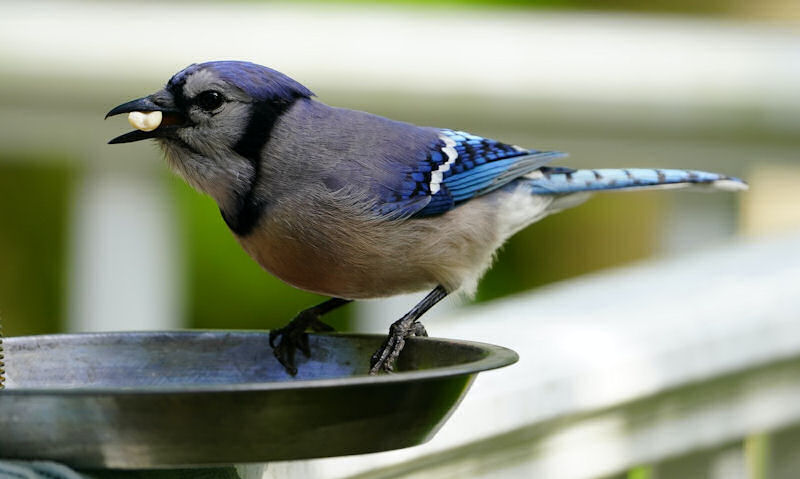What kind of feeders do Blue Jays like
Easy at it is to know Blue Jays are frequenting your yard with their loud bird calls, this will tell you its feeding time thus an appropriate bird feeder is in need.
What kind of feeders do Blue Jays like are seed-filled bird feeders; while favoring open top or highly accessible feeders more - due to their lack of ability on small compact feeders due to their enormous size. Kind of feeders' Jays like are hanging hopper feeders, ground or pole mounted platform feeders.
Most colorful common backyard bird next to Northern Cardinals, Blue Jays are readily available in our yards thus the need to feed them is essential more than ever.
Jays can be fed all types of common bird seed mixes with more of a liking towards sunflower seeds, which are seen to be their favorites.
To know what Blue Jays like to eat is important as its what they eat in the wild is what must be added to bird feeders, in order to attract them to it.
With that being said, there are many kinds of bird food you can attract Jays to without a feeder in sight - including dried mealworms, cracked corn and oats.
To attract Blue Jays to your yard and therefore your feeder, let's provide Jays what they came for - which is seeds in an unobstructed bird feeder hung up in safety.
By offering cheaper seed mixes plus sunflower, niger or safflower seeds in a feeder, you'll sure to see them eaten up. Only these often larger seed mixes can't be offered up in the kind of clear tube seed feeder, commonly made for smaller birds.
Oh no... what you must do is offer seeds in a hopper or lantern style seed feeder, as the seeds will filter via the bottom out into a wide seed tray - where the seeds are exposed to the elements - and whereby this area doubles up as an accessible perch for Jays.
Seeds being a favorite, let's not forget Blue Jays do love their suet cakes, but to offer suet out in the open is best - but to use a suet cake feeder you'd need to stabilize it rather than allow it to just hang.
Nuts are also fed to Jays but never add peanuts to a feeder, if you like you can mix them in with seeds while offering peanuts in or out their shells to Blue Jays on an open top platform feeder or heavy dish.
Blue Jays prefer seed feeders
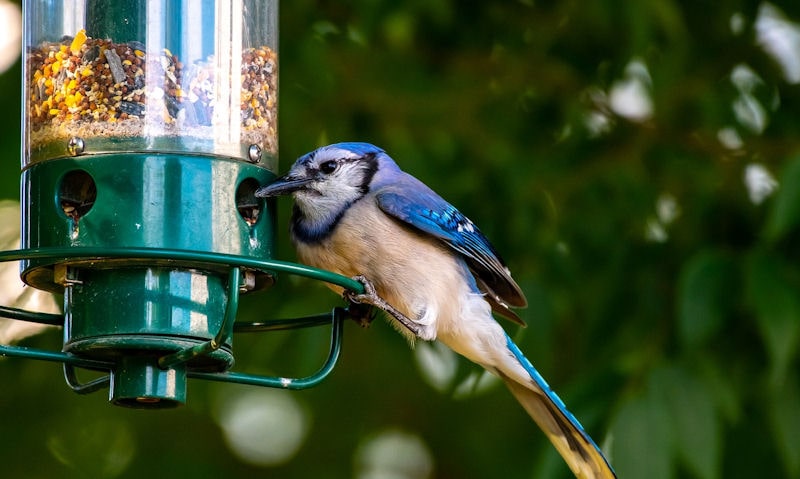
Certainly no shortage of the kind of seed bird feeders liked by Blue Jays, only due to their lack of adaptability at feeders - the seed feeder will be limited to accessible types - to allow a larger bird to perch.
What kind of seed feeders are best for Blue Jays would be the hopper style bird feeder of course.
Why that is because a mounted or more of the common hanging hopper bird feeders use wide, open perches along with seed mixes filter out to birds in a way they are less obstructed - yet can allow birds like Blue Jays to feed with ease.
Blue Jays can often perch on tight perch placements, only an open hopper bird feeder will be sure there's no limits to Jays.
What kind of bird seed do Blue Jays eat and therefore must be available in any kind of seed feeder, can be one of or a mix of all sunflower seeds, niger seeds which can also go in a Nyjer seed feeder, and safflower seeds - plus cheaper wild bird seed mixes.
Other ways to attract Blue Jays to the seed feeder is to use cracked corn, in their shell peanuts - plus the all important dried mealworms.
Jays take a particular liking to sunflower seeds thus this variety must be prioritized.
Seed filled suet cages too
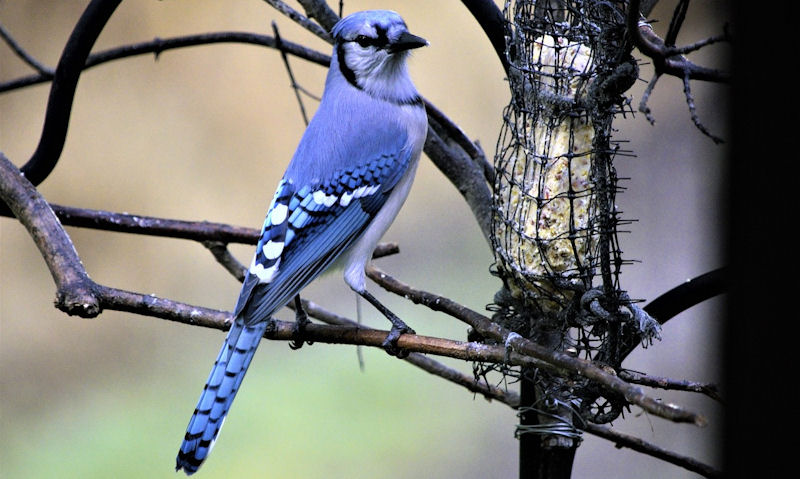
Where else you'll succeed in attracting Blue Jays to a feeder is if offering up suet. Now, Blue Jays can perch on a cage feeder though we must remember it can be difficult.
In fact, you are more likely to see Blue Jays perch on top of a suet cake bird feeder or using an adjacent perch placement - rather than Jays seen clinging to the side of the cage in a way smaller birds have adapted to.
Other than seed feeders then, Blue Jays really do like suet cake feeders but only if they are accessible.
How to attract Blue Jays to bird feeders is easy as can be, but seeing Jays using it without restrictions in place is a different matter.
What you must do with any kind of suet cake or fat ball feeder is rather than let it swing precariously on a tree branch or bird feeder pole; position the suet bird feeder in a way that it is leaning on a branch or pole to stabilize it enough for Jays to feed on.
Blue Jays can eat many things at bird feeders thus a seed, fruit, insect or nut-filled suet cake can be taken a liking to.
Blue Jay benefits more on platform
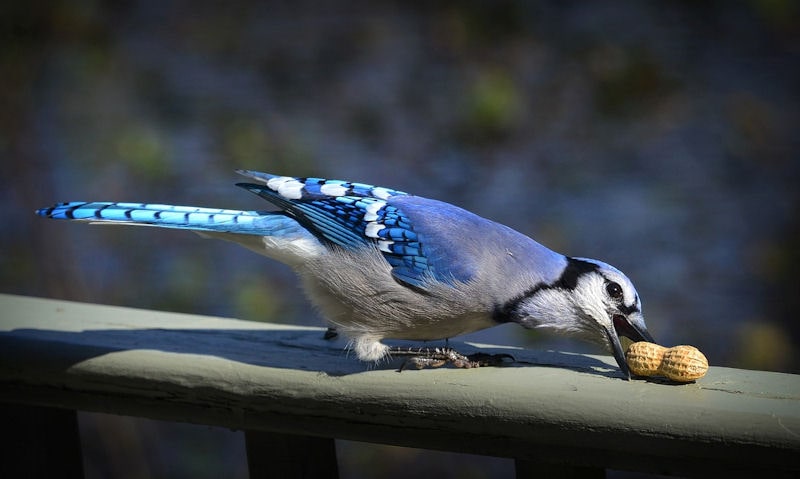
As one of the largest, most common backyard birds in North America, you'd simply see Blue Jays struggle to eat on feeders designed for our more common smaller birds.
Jays can absolutely perch on a short perch at seed feeders or indeed choose to cling at an awkward angle on a wire bird feeder, if it means Blue Jays can eat. But remember that isn't to say its made easy on Jays.
Oh no, what better way to feed Jays in your yard than with an open top platform bird feeder - sitting on a pole or place the platform on the ground.
Blue Jays are ground eaters birds after all, thus are likely to forage on the lawn where they can hop on to a ground platform bird feeder, filled with all their favorites.
Open top platform bird feeders can allow all size birds to feed with zero restrictions in place; whereby a pole mounted platform bird feeder despite being higher up off the ground - is as easy as ever for Jays to perch on.
Blue Jays and other less able birds at feeders will benefit on an open to all platform bird feeder, among any other kind of bird feeder.
Jays like to feed on the lawn or take bird food on a flat surface such as a deck railing which doesn't depend on a feeder at all. Only a platform bird feeder on a pole or a feeder on the ground can keep bird feeding organized.
Nuts can be offered up
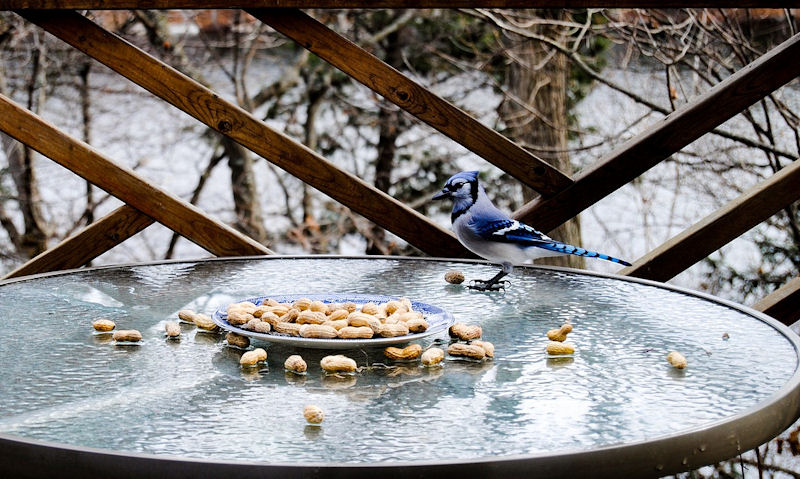
Of all things Blue Jays love to eat peanuts - be it roasted or raw peanuts - while more importantly Jays like to use their hard bill to break open nuts in their shells.
To know that, its vital to offer Blue Jays any kind of nuts if you like with a likeness more towards peanuts.
No kind of peanut bird feeder would be a favorite of Blue Jays as the often made in wire mesh nut feeders can be restricting.
What you can do is only offer peanuts raw or in shells mixed in with their bird seed blend.
The hope is Jays will eat their favorite seeds as expected while also eating the available peanut meat mixed in.
Never depend on any kind of feeder to store up nuts when the only place to offer nuts for Blue Jays will be on the platform bird feeder, on garden furniture, the deck railing - or if you like you can pile peanuts in a heavy ceramic dish to prevent it tipping over.
I understand you what to know what feeders Blue Jays like most, but as it happens you don't need to use bird feeders at all.
In fact, there's no harm in throwing bird seeds on the ground or piling peanuts on the deck.
If its an area in your yard Blue Jays frequent daily, then take advantage of their whereabouts by placing their favorite seeds, suet or nuts in this same area.
To sum it up
What kind of feeders do Blue Jays like are those that store seed mixes. With that in mind you don't really want to use any kind of seed feeder as it can be restricting to a larger bird, like Jays.
Favor what is a wooden hopper bird feeder hung up on a branch or bracket; as the long, wide perching area can make it easy on feeding Blue Jays.
Seed feeders for use by smaller birds like Finches can be used, such as a hanging panoramic, lantern or a hexagon style seed feeder - but the lack of perching area can make it hard on Jays.
What you must focus on is primarily a hanging seed feeder still for safety reasons, while making sure it comes with a far reaching out perch.
Blue Jays like the kind of seed feeder that doesn't force them into an awkward position, even if they can - but rather allow Jays to eat the seeds in a comfortable manner.
Jays also like suet of any kind thus a suet cake or fat ball feeder will go down a storm.
Never allow Blue Jays to perch on a compact suet cage feeder which will only sway or swing as they perch; when the same suet cake feeder can lean or be wedged on an adjacent branch or on the bird feeder pole to keep it steady.
Seed mixes plus suet in all its form can be placed on an open to all platform bird feeder, in which Jays like the most as they can never obstructed.
Consider a ground platform bird feeder for Jays to eat at a level they are most comfortable with - whilst a pole mounted platform bird feeder will see just as much use, with no restrictions at all.
